✨✨✨✨✨✨✨✨✨✨✨✨✨✨✨✨✨✨✨✨✨✨✨✨✨✨✨✨✨✨✨✨✨✨✨✨✨✨✨✨✨✨
💗💗你总会迎来那束光,或早,或晚 💗💗
✌✌让我们一起学习axios吧
✨✨✨✨✨✨✨✨✨✨✨✨✨✨✨✨✨✨✨✨✨✨✨✨✨✨✨✨✨✨✨✨✨✨✨✨✨✨✨✨✨✨
axios 是目前前端最热门的请求工具, 用来向服务器发送 AJAX 请求进行数据交换.目前在面试时也经常被面试官问到的一个知识点,所以呢,在学习前有ajax,promise的前置知识的一个基础就最好啦,还没有学这两个知识的小伙伴可以看一下这两篇文章,希望对你有帮助哦~,接下来的文章是我学习axios的总结,快来一起学习吧!
ajax文章链接:https://blog.csdn.net/m0_46615524/article/details/125829369?spm=1001.2014.3001.5501
promise文章链接:https://blog.csdn.net/m0_46615524/article/details/126068415?spm=1001.2014.3001.5501
文章目录
1.学习axios前的准备👈
1.安装json-server
安装这个json-server可以在30秒之内不用做任何编码就可以为我们创建一个假的,基于 REST API 的一个服务,可以让我们更好的通过axios获得数据
https://github.com/typicode/json-server
打开集成终端输入:npm install -g json-server
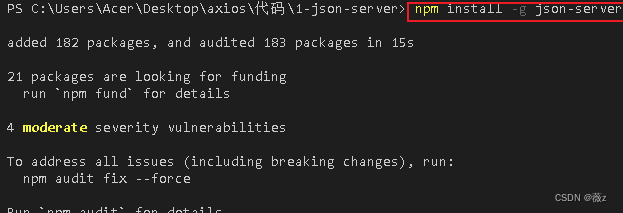
2.配置 db.json
{
"posts": [
{ "id": 1, "title": "json-server", "author": "typicode" }
],
"comments": [
{ "id": 1, "body": "some comment", "postId": 1 }
],
"profile": { "name": "typicode" }
}
3.开启json-server
在有db.json文件的文件夹下的终端输入:json-server --watch db.json,启动服务
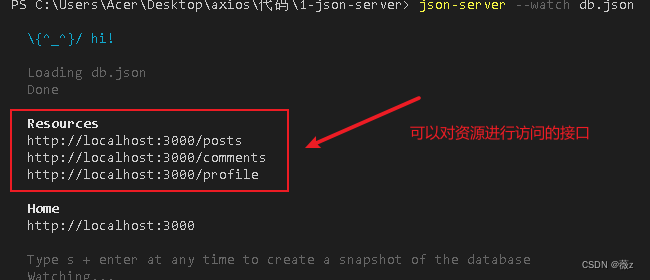
2.axios的理解和使用👈
1.axios是什么?
- 前端最流行的 ajax 请求库 , Axios,是一个基于promise 的网络请求库,作用于node.js和浏览器中,它是 isomorphic 的(即同一套代码可以运行在浏览器和node.js中)。在服务端它使用原生node.js ,http模块, 而在客户端 (浏览端) 则使用XMLHttpRequest 。
- react/vue 官方都推荐使用 axios 发 ajax 请求
- 文档: https://github.com/axios/axios
2.axios 特点
- 基于 xhr + promise 的异步 ajax 请求库
- 浏览器端/node 端都可以使用
- 支持请求/响应拦截器
- 支持请求取消
- 请求/响应数据转换
- 批量发送多个请求
3.axios常用语法
1.get请求
btns[0].onclick = function(){
//发送 AJAX 请求
axios({
//请求类型
method: 'GET',//获取数据
//URL
url: 'http://localhost:3000/posts/1',
}).then(response => {
console.log(response);
});
}
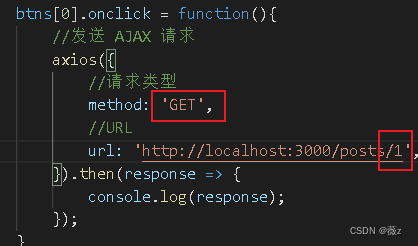
💬说明:获取id为1的文章
2.post请求
//添加一篇新的文章
btns[1].onclick = function(){
//发送 AJAX 请求
axios({
//请求类型
method: 'POST',
//URL
url: 'http://localhost:3000/posts',
//设置请求体
data: {
title: "今天天气不错, 还挺风和日丽的",
author: "张三"
}
}).then(response => {
console.log(response);
});
}
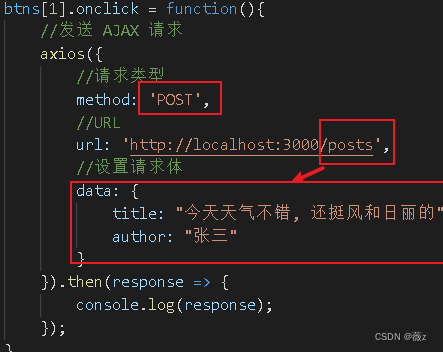
💬说明:添加一篇id为2的文章,内容为请求体里的内容
3.put请求
//更新数据
btns[2].onclick = function(){
//发送 AJAX 请求
axios({
//请求类型
method: 'PUT',
//URL
url: 'http://localhost:3000/posts/3',
//设置请求体
data: {
title: "今天天气不错, 还挺风和日丽的",
author: "李四"
}
}).then(response => {
console.log(response);
});
}
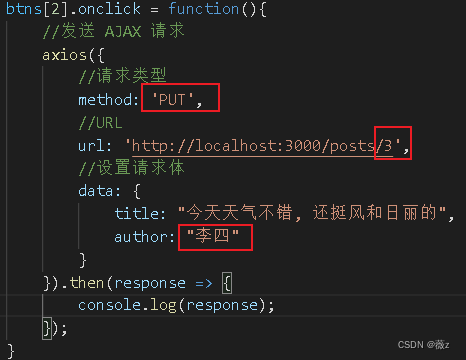
💬说明:修改id为3的文章,将author改为李四
4.delete请求
//删除数据
btns[3].onclick = function(){
//发送 AJAX 请求
axios({
//请求类型
method: 'delete',
//URL
url: 'http://localhost:3000/posts/3',
}).then(response => {
console.log(response);
});
}
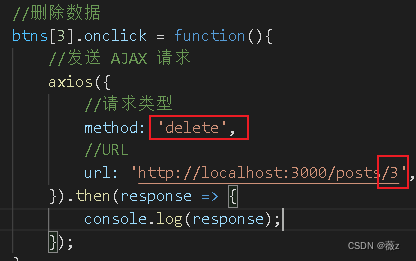
💬说明:删除id为3的文章
4.axios的其他语法
axios(config): 通用/最本质的发任意类型请求的方式
axios(url[, config]): 可以只指定 url 发 get 请求
axios.request(config): 等同于 axios(config)
axios.get(url[, config]): 发 get 请求
axios.delete(url[, config]): 发 delete 请求
axios.post(url[, data, config]): 发 post 请求
axios.put(url[, data, config]): 发 put 请求
axios.defaults.xxx: 请求的默认全局配置
axios.interceptors.request.use(): 添加请求拦截器
axios.interceptors.response.use(): 添加响应拦截器
axios.create([config]): 创建一个新的 axios(它没有下面的功能)
根据指定配置创建一个新的 axios, 也就就每个新 axios 都有自己的配置新 axios 只是没有取消请求和批量发请求的方法, 其它所有语法都是一致的为什么要设计这个语法?
(1) 需求: 项目中有部分接口需要的配置与另一部分接口需要的配置不太一
样, 如何处理
(2) 解决: 创建 2 个新 axios, 每个都有自己特有的配置, 分别应用到不同要 求的接口请求中
axios.Cancel(): 用于创建取消请求的错误对象
axios.CancelToken(): 用于创建取消请求的 token 对象
axios.isCancel(): 是否是一个取消请求的错误
axios.all(promises): 用于批量执行多个异步请求
axios.spread(): 用来指定接收所有成功数据的回调函数的方法
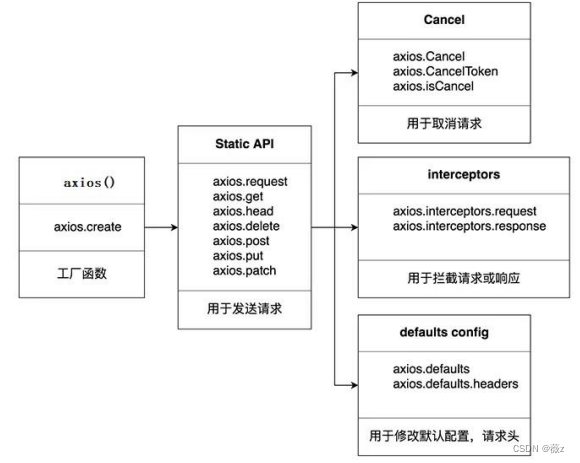
列举
<script>
//获取按钮
const btns = document.querySelectorAll('button');
//发送 GET 请求
btns[0].onclick = function(){
// 相当于axios()
axios.request({
method:'GET',
url: 'http://localhost:3000/comments'
}).then(response => {
console.log(response);
})
}
//发送 POST 请求
btns[1].onclick = function(){
// axios()
axios.post(
'http://localhost:3000/comments', //url
{ //请求体
"body": "喜大普奔",
"postId": 2
}).then(response => {
console.log(response);
})
}
</script>
结果:

3.axios请求响应结果的结构👈
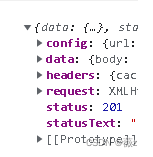
1.config:响应结果的配置对象,里面包含请求头,请求类型,请求体等等数据
2.data:是响应体的结果,服务器返回的结果,是一个对象,这是axios自动将服务器返回成功进行了json解析
3.headers:响应头信息
4.request:原生的ajax请求对象,axios发生ajax请求,需要用到底层的xmlHttpRequest的实例对象,而request保存的就是当前axios发送请求时所创建的ajax请求对象,也就是xmlHttpRequest的实例对象
5.status:响应状态码
6.statusTest:响应状态字符串
4.axios的默认配置👈
配置axios的默认配置可以在后续代码中减少重复性的代码的书写
<script>
//获取按钮
const btns = document.querySelectorAll('button');
//默认配置
axios.defaults.method = 'GET';//设置默认的请求类型为 GET
axios.defaults.baseURL = 'http://localhost:3000';//设置基础 URL
axios.defaults.params = {id:100};
axios.defaults.timeout = 3000;//
btns[0].onclick = function(){
axios({
url: '/posts'
}).then(response => {
console.log(response);
})
}
</script>
5.axios创建实例对象👈
<script>
//获取按钮
const btns = document.querySelectorAll('button');
//创建实例对象 /getJoke
const duanzi = axios.create({
baseURL: 'https://api.apiopen.top',
timeout: 2000
});
const onather = axios.create({
baseURL: 'https://b.com',
timeout: 2000
});
//这里 duanzi 与 axios 对象的功能几近是一样的
// duanzi({
// url: '/getJoke',
// }).then(response => {
// console.log(response);
// });
duanzi.get('/getJoke').then(response => {
console.log(response.data)
})
</script>
6.axios的拦截器👈
- 说明: 调用 axios()并不是立即发送 ajax 请求, 而是需要经历一个较长的流程
- 流程: 请求拦截器2 => 请求拦截器1 => 发ajax请求 => 响应拦截器1 => 响
应拦截器 2 => 请求的回调 - 注意: 此流程是通过 promise 串连起来的, 请求拦截器传递的是 config, 响应
拦截器传递的是 response
<script>
// Promise
// 设置请求拦截器 config 配置对象
axios.interceptors.request.use(function (config) {
console.log('请求拦截器 成功 - 1号');
//修改 config 中的参数
config.params = {a:100};
return config;
}, function (error) {
console.log('请求拦截器 失败 - 1号');
return Promise.reject(error);
});
axios.interceptors.request.use(function (config) {
console.log('请求拦截器 成功 - 2号');
//修改 config 中的参数
config.timeout = 2000;
return config;
}, function (error) {
console.log('请求拦截器 失败 - 2号');
return Promise.reject(error);
});
// 设置响应拦截器
axios.interceptors.response.use(function (response) {
console.log('响应拦截器 成功 1号');
return response.data;
// return response;
}, function (error) {
console.log('响应拦截器 失败 1号')
return Promise.reject(error);
});
axios.interceptors.response.use(function (response) {
console.log('响应拦截器 成功 2号')
return response;
}, function (error) {
console.log('响应拦截器 失败 2号')
return Promise.reject(error);
});
//发送请求
axios({
method: 'GET',
url: 'http://localhost:3000/posts'
}).then(response => {
console.log('自定义回调处理成功的结果');
console.log(response);
});
</script>
输出:
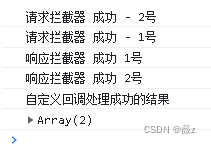
7.axios取消请求👈
1.基本流程
①配置 cancelToken 对象
②缓存用于取消请求的 cancel 函数
③ 在后面特定时机调用 cancel 函数取消请求
④在错误回调中判断如果 error 是 cancel, 做相应处理
<script>
//获取按钮
const btns = document.querySelectorAll('button');
//2.声明全局变量
let cancel = null;
//发送请求
btns[0].onclick = function(){
//检测上一次的请求是否已经完成
if(cancel !== null){
//取消上一次的请求
cancel();
}
axios({
method: 'GET',
url: 'http://localhost:3000/posts',
//1. 添加配置对象的属性
cancelToken: new axios.CancelToken(function(c){
//3. 将 c 的值赋值给 cancel
cancel = c;
})
}).then(response => {
console.log(response);
//将 cancel 的值初始化
cancel = null;
})
}
//绑定第二个事件取消请求
btns[1].onclick = function(){
cancel();
}
</script>
对于axios的学习暂时到这里结束啦~